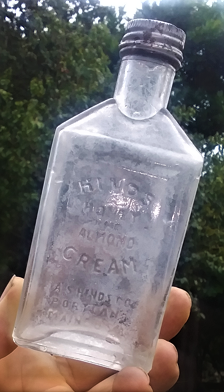 |
| Long Distance, A. M. DODGE, INC bottle find. |
This bottle is embossed Long Distance on the shoulder, and on the heal, A. M. DODGE, INC.
Featuring mostly glass bottles but also ceramics and other miscellaneous items
 |
| Long Distance, A. M. DODGE, INC bottle find. |
 |
| Embosded; HINDS HONEY AND ALMOND CREAM. A S HINDS CO. PORTLAND MAINE USA. |
Here is one of many ads for Hinds Honey and Almond Cream lotion. You can find them by using the link below. It was advertised for sunburn, younger skin, etc.
The family business was the A. S. Hinds Co. in Portland which was famous for various creams for the face, hands, and Skin. The A.S. Hinds company was started in 1875. They were bought out in 1907 by Lehn & Fink, maker of Lysol. The honey almond cream product was still available in 1948.
Hinds Honey and Almond Cream was formulated and marketed by Aurelius Stone Hinds in Portland Maine. He moved to Portland in 1862 and worked in a drugstore, which he bought in 1870. He worked on the formulation of the cream for a number of years, and began selling it from the drugstore probably sometime in the latter part of the 1870's. It was such a huge success that he soon had to put it into commercial production, first in Portland, and at some point distribution was shifted to a company in New Jersey. A number of different bottles from the very early days of the product are commonly found, but unfortunately, they do not carry a date...
Friends Of Hinds - A.S. Hinds Company
 |
| Same Bottle Shown Above. |
 |
| Sauer's Extract Bottle. |
 |
| Embossing on Sauer's Extract Bottle. |
 |
| Sauer's Extract Bottle. Source: See gjenwick.com link below. |
Sauer's Extract | Vintage Ads (gjenvick.com)
And here is a link for a timeline on the company.
Sauer Brands History: Founding, Timeline, and Milestones (zippia.com)
By the way, the Sauer's company is another Richmond, Virginia company. As I've mentioned, a lot of the early 20th century bottles I've found around the Treasure Coast come from the East Coast of the U.S. Not surprising.
 |
| Here is a Treasure Coast Bottle Find: Piso's Consumption Cure. Top photo embossing: TRADE PISO'S MARK. Bottom photo embossing: PISO CO. WARREN PA. U. S. A. |
Talbott’s original formula for Piso’s Cure included opium and possibly other morphine derivatives. But the immediate post-Civil War era brought a revulsion against those drugs as many returning veterans had developed addictions to them as a result of treatment for their wounds. Although Congress only later outlawed opium-derived ingredients in patent medicines, the Trio saw the ban coming and by 1872, according to company literature, eliminated opium and morphine from Piso’s ingredients. They later won a lawsuit on that score. The medicine still contained cannabis (marijuana), chloroform, and alcohol, but Piso’s label did not mention them.
Below is a trade card image advertising Piso's cure for consumption and catarrh.
Whether it was the effects of the Great Depression or the 1937 passage of the Marijuana Tax Act, effectively barring cannabis in medicine, Piso’s corporate life ended before World War II...
Here is a link with much more information on the Piso company and its medicines.
BandE_Pages_1-24.pmd (fohbc.org)
The bottom reads, "THIS CUP HOLDS A HEAPING DESSERT SPOONFUL." Around the rim are heavily embossed numbers - 1 thorugh 12.
The cup is in good condition but was a bit puzzling. A little research soon gave me the answer.
It is the top of the John Wyeth and Brothers Effervescent Sodium Phosphate bottle shown below.
The bottom of the bottle is marked, "PAT MAY 16 1899."
I've seen many examples of the cup for sale for a few dollars - usually around five or six dollars.
The patent date suggests that the bottle is probably from the early 20th century.
Below is the link to the web site that provided the above picture.
http://www.bottlebooks.com/questions/august2001/august%202001%20questions.htm
Complete examples of this bottle type with this same embossing are from John Wyeth & Bro. and the bottle rim would have had a dose glass resting on it and the bottle said “TAKE NEXT DOSE AT” and then a mark so the dose glass can be rotated to the hour marked at its base.
This type of bottle was patented in 1899. Only the older bottles from this manufacturer are blue but it is not known when this bottle color was phased out. These bottles were handblown until 1910 which is also around the estimated time when the deep cobalt blue was discontinued.
Embossed LICORERIA LA BODEGA INC. PONCE, P.R. The Federal Law message pretty much dates the bottle. The trade mark seems to be a sailing ...
